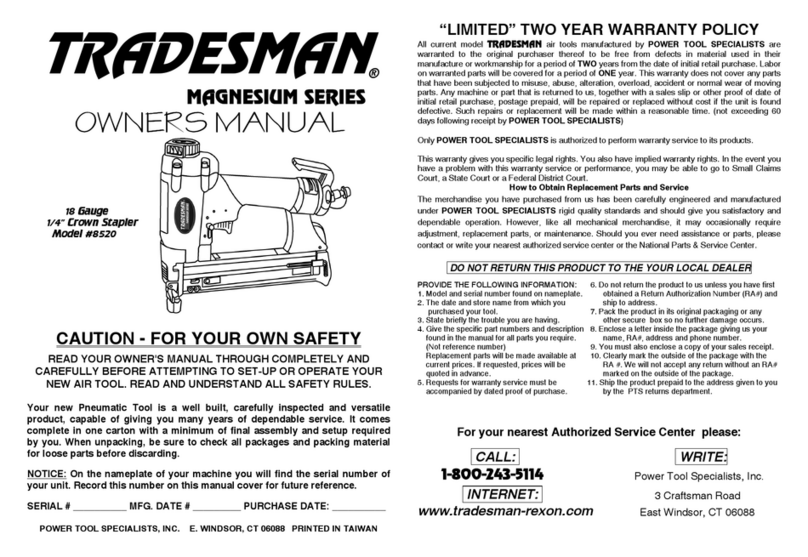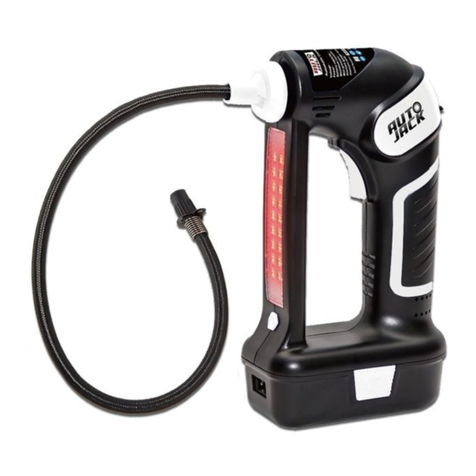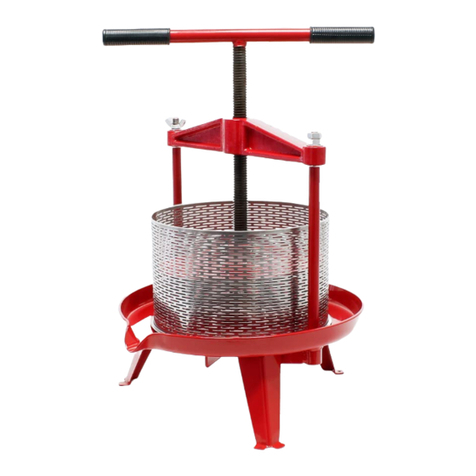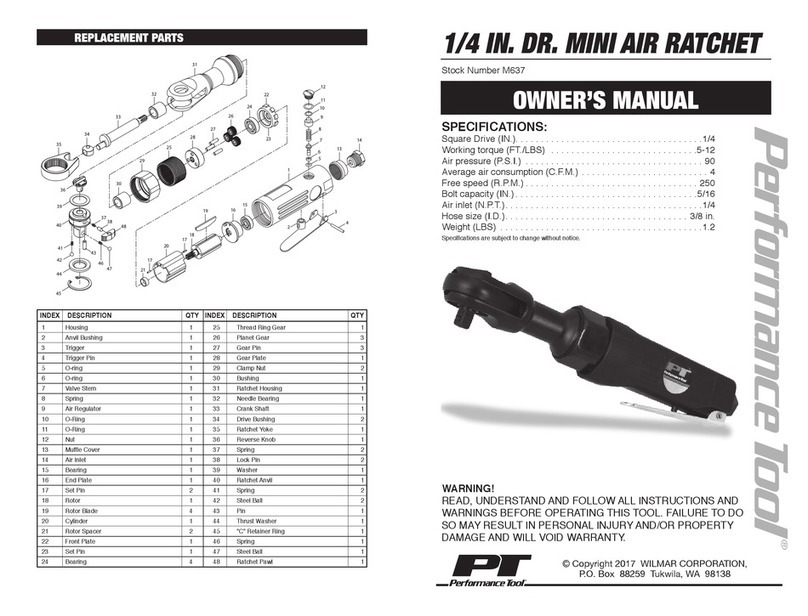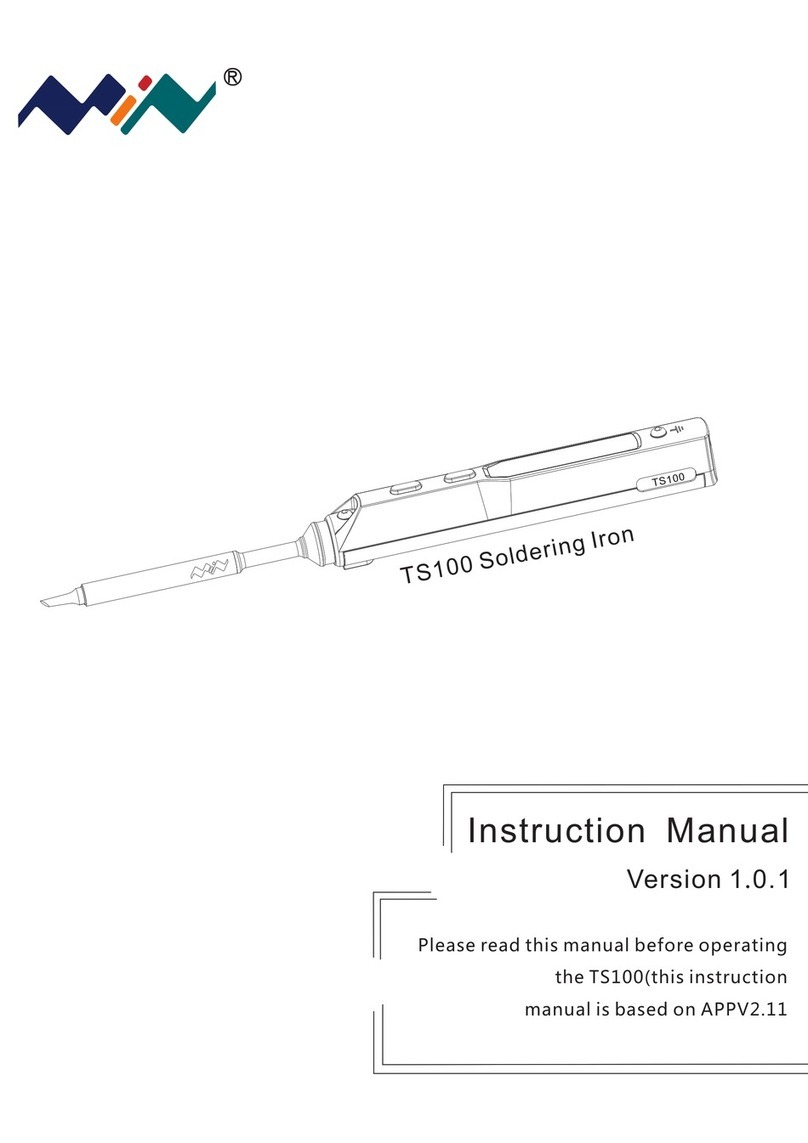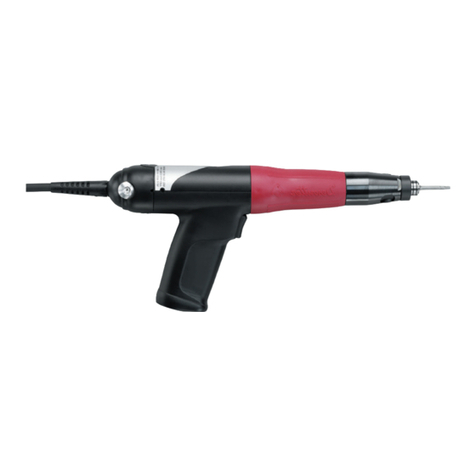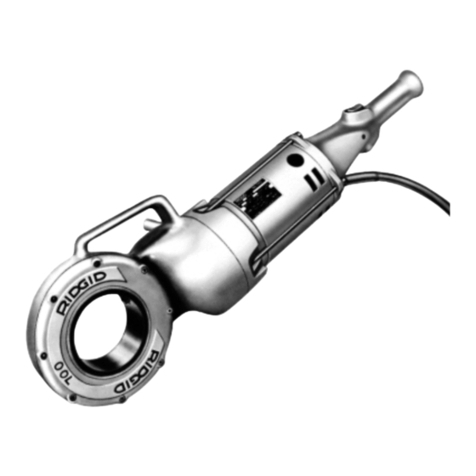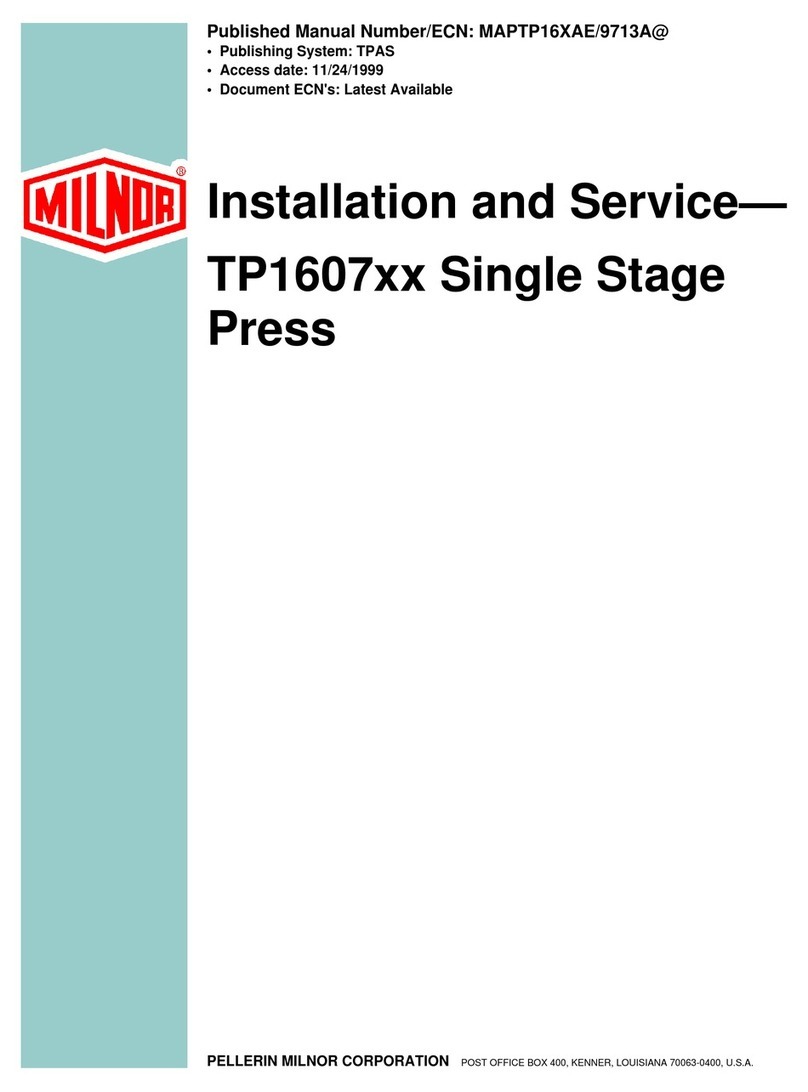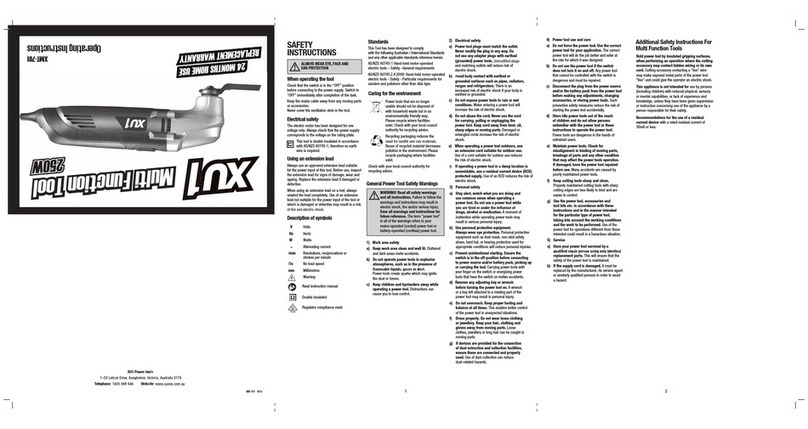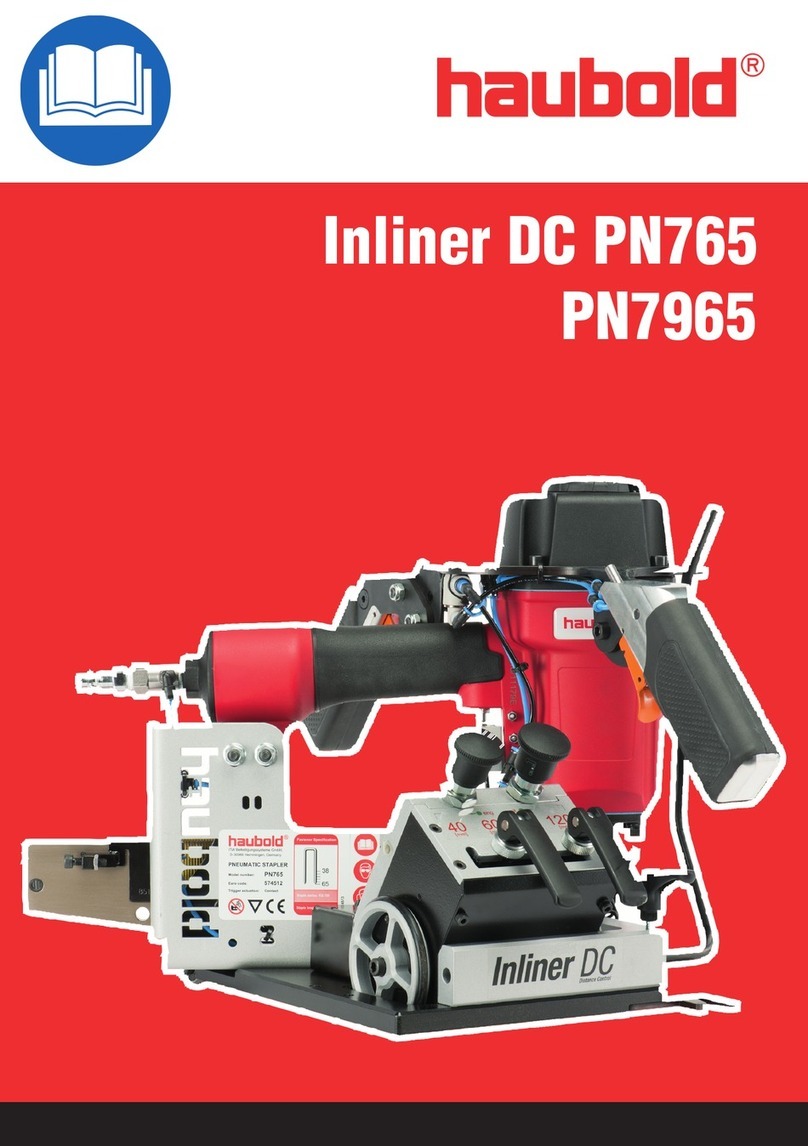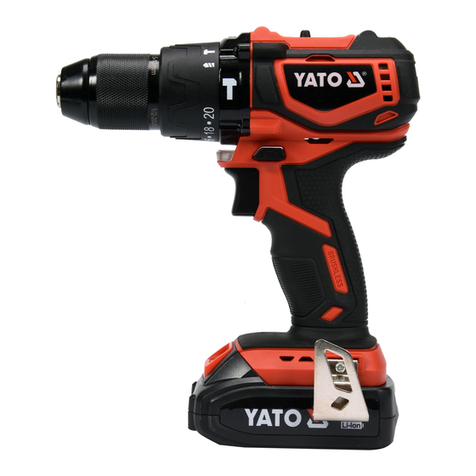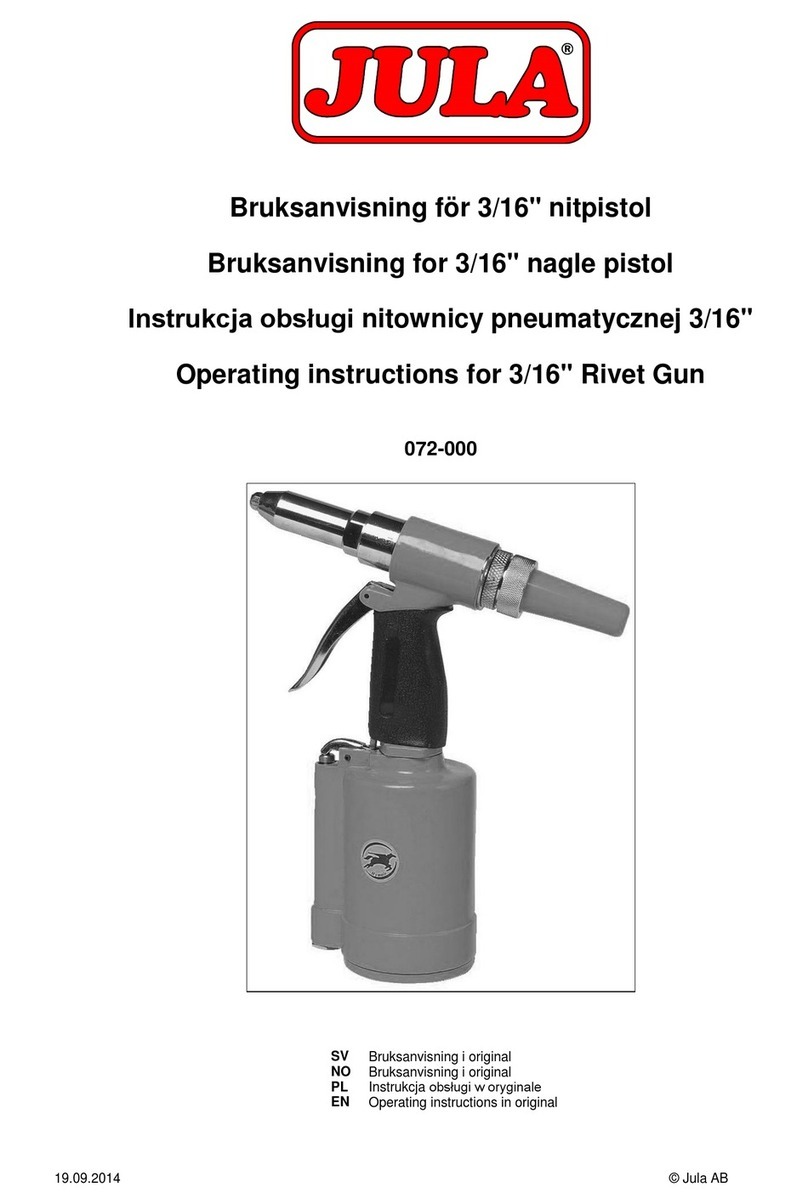Tradesman DP12LW User manual

OWNER’S MANUA
L
TRADESMAN
®
12” DRILL PRESS WITH LASER GUIDE
Model # DP12LW
Item #52759
CAUTION – FOR YOUR OWN SAFETY
READ YOUR OWNER’S MANUAL THROUGH COMPLETELY AND CAREFULLY BEFORE
ATTEMPTING TO SET-UP OR OPERATE YOUR NEW POWER TOOL.
ALL OPERATORS OF THIS EQUIPMENT SHOULD READ AND UNDERSTAND ALL SAFETY
RULES PRINTED ON THE MACHINE AND THIS OWNERS MANUAL BEFORE USE.
Your new Power Tool is a well built, carefully inspected versatile machine, capable of giving
you many years of dependable service. Your power tool comes complete in one carton with
a minimum of first assembly and setup required by you. When unpacking , be sure to check
all packages and packing material for loose parts before discarding.
NOTICE: On the nameplate of your machine you will find the serial number and MFG date code of
your unit. Please record these numbers on this manual cover for future service reference.
SERIAL # MFG. DATE # PURCHASE DATE: .
POWER TOOL SPECIALISTS, INC E.WINDSOR,CT 06088 PRINTED IN CHINA
www.tradesman-rexon.com
1-800-243-5114

TABLE OF CONTENTS
PRODUCT SPECIFICATIONS
Chuck Size ……….……..…..….. 1/2”
Speed ……..………..…….……... 12 (250 ~ 3,100 RPM)
Motor…………………….……… 120V, 60 Hz, 6 Amps
Horsepower………….………..… 2/3 HP (Max. Developed)
Table Size ………………..….…. 10-5/16” x 8-21/32”
Table Tilt …….………….…….… 45° Right or Left
Spindle Travel…………………… 2-3/8”
Throat …………………………… 6”
Base Size …………….…….…… 14-3/8” x 8-1/4”
Height ………….………………… 37-5/16”
WARRANTY
Refer to the Warranty Card included for your power tool warranty information.
WARNING
SECTION PAGE SECTION PAGE
Product Specifications …………………….. 2 Know Your Drill Press ……...…….……… 8
Power Tool Safety ..……………………….. 3 Drill Press Glossary ………………………. 9
Drill Press Safety ………………………..… 4 Assembly …………………………………. 10
Electrical Requirements and Safety……….. 5 Adjustments……………………..………… 13
Accessories and Attachments……………… 6 Operation…………………………………. 16
Tools Required For Assembly…………...... 6 Maintenance ……………………………… 20
Carton Contents …………………………… 7 Troubleshooting Guide.…………………... 21
2
Some dust created by power sanding, sawing, grinding, drilling and other construction activities contains chemicals (known to
the State of California) to cause cancer, birth defects or other reproductive harm. Some examples of these chemicals are:
• Lead based paints
• Crystalline silica from bricks, cement and other masonry products
• Arsenic and chromium from chemically treated lumber
Your risk from these exposures varies, depending on how often you do this type of work. To reduce your exposure to these
chemicals: work in a well ventilated area and work with approved safety equipment such as those dust masks that are specially
designed to filter out microscopic particles.

POWER TOOL SAFETY
BEFORE USING THIS DRILL PRESS
Safety is a combination of common sense, staying alert and
knowing how to use your drill press.
CAUTION!
To avoid mistakes that could cause serious injury, do not plug
the drill press in until you have read and understood the
following.
1. READ
and become familiar with the entire instruction
manual. LEARN the tool’s application, limitations and
possible hazards.
2. KEEP GUARDS IN PLACE and in working order.
3. DON’T USE IN DANGEROUS ENVIRONMENTS.
Don’t use power tools in damp and wet locations, or expose
them to rain. Keep work area well lighted.
4. DO NOT
use power tools in the presence of flammable
liquids or gases.
5. KEEP WORK AREA CLEAN. Cluttered areas and
benches invited accidents.
6. KEEP CHILDREN AWAY. All visitors should be kept
safe distance from work area.
7. DON’T FORCE THE TOOL. It will do the job better and
safer at the rate for which it was designed.
8. USE THE RIGHT TOOL. Do not force a tool or an
attachment to do a job for which it was not designed.
9. WEAR PROPER APPAREL. Do not wear loose clothing,
gloves, neckties, rings, bracelets, or other jewelry which may
get caught in moving parts. Nonslip footwear is
recommended. Wear protective hair covering to contain long
hair.
10. WEAR A FACE MASK OR DUST MASK where a
drilling operation produces dust.
11. DISCONNECT TOOLS before servicing; when changing
accessories such as blades, bits, cutters, and the like.
12. REDUCE THE RISK OF UNINTENTIONAL
STARTING. Make sure the switch is in the off position
before plugging in.
13. USE RECOMMENDED ACCESSORIES. Consult the
owner’s manual for recommend accessories. The use of
improper accessories may cause risk of injury to persons.
14. REMOVE ADJUSTING KEYS AND WRENCHES.
Form habit of checking to see that keys and adjusting
wrenches are removed from the tool before turning it ON.
15. NEVER LEAVE A TOOL RUNNING UNATTEND.
TURN THE POWER “OFF”. Don’t leave the tool until it
comes to a complete stop.
16. NEVER STAND ON THE TOOL. Serious injury could
occur if the tool is tipped or if the cutting tool is
unintentionally contacted.
17. DON'T OVERREACH. Keep proper footing and balance at
all times.
18. MAINTAIN TOOLS WITH CARE. Keep tools sharp and
clean for best and safest performance. Follow instructions
for lubricating and changing accessories.
19. CHECK FOR DAMAGED PARTS. Before further use of
the tool, a guard or other part that is damaged should be
carefully checked to determine that it will operate properly
and perform its intended function – check for alignment of
moving parts, binding of moving parts, breakage of parts,
mounting, and any other conditions that may affect its
operation. A guard or other part that is damaged should be
properly repaired or replaced.
20. MAKE WORKSHOP CHILD PROOF with padlocks,
master switches, or by removing starter keys.
21. DO NOT operate the tool if you are under the influence of
any drugs, alcohol or medication that could affect your
ability to use the tool properly.
22.
DUST generated from certain material can be hazardous to
your health. Always operate the drill press in a well-
ventilated area and provide for proper dust removal. Use a
dust collection system whenever possible.
23.
ALWAYS WEAR EYE PROTECTION. Any drill press
can throw foreign objects into the eyes and could cause
permanent eye damage. ALWAYS wear Safety Goggles (not
glasses) that comply with ANSI Safety standard Z87.1
Everyday eyeglasses have only impact –resistance lenses.
They ARE NOT safety glasses. NOTE: Glasses or goggles
not in compliance with ANSI Z87.1 could seriously hurt
you when they break.
3

DRILL PRESS SAFETY
CAUTION!
For your own safety, do not try to use your drill press or plug it
in until it is completely assembled and installed according to the
instructions, and until you have read and understood this
instruction manual:
1. YOUR DRILL PRESS MUST BE BOLTED securely to
a workbench. In addition, if there is any tendency for your
drill press to move during certain operations, bolt the
workbench to the floor.
2. THIS DRILL PRESS is intended for use in dry conditions,
indoor only.
3. WEAR EYE PROTECTION. USE A face or dust mask
along with safety goggles if drilling operation is dusty. USE
ear protectors, especially during extended periods of
operation.
4. DO NOT
wear gloves, neckties, or loose clothing.
5. DO NOT
try to drill material too small to be securely held.
6. ALWAYS
keep hands out of the path of a drill bit. Avoid
awkward hand positions where a sudden slip could cause
your hand to move into the drill bit.
7. DO NOT
install or use any drill bit that exceeds 175 mm
(7”) in length or extends 150 mm (6”) below the chuck jaws.
They can suddenly bend outward or break.
8. DO NOT USE wire wheels, router bits, shaper cutters,
circle (fly) cutters, or rotary planers on this drill press.
9. WHEN
cutting a large piece of material ,make sure it is
fully supported at the table height.
10. DO NOT
perform any operation freehand. ALWAYS use
clamps or a vise.
11. MAKE SURE
there are no nails or foreign objects in the
part of the workpiece to be drilled.
12. CLAMP THE WORKPIECE OR BRACE IT against the
left side of the column to prevent rotation. If it is too short
or the table is tilted, clamp it solidly to the table.
13. IF THE WORKPIECE overhangs the table such that it
will fall or tip if not held, clamp it to the table or provide
auxiliary support.
14. SECURE THE WORK.
Use clamps or a vise to hold the
work when practical. It’s safer than using your hand and it
frees both hands to operate tool.
15. WHEN using a drill press vise, always fasten to the table.
16. MAKE SURE all clamps and locks are firmly tightened
before drilling.
17. SECURELY LOCK THE HEAD and table support to the
column, and the table to the table support before operating
the drill press.
18. NEVER turn your drill press on before clearing the table of
all objects (tools, scraps of wood, etc.)
19. BEFORE STARTING
the operation, jog the motor switch
to make sure the drill bit does not wobble or vibrate.
20. LET THE SPINDLE REACH FULL SPEED before
starting to drill. If your drill press makes an unfamiliar
noise or if it vibrates excessively, stop immediately, turn
the drill press off and unplug. If do not restart the unit until
the problem is corrected.
21. DO NOT
perform layout assembly or set up work on the
table while the drill press is in operation.
22. USE THE RECOMMENDED SPEED for any drill press
accessory and for different workpiece material. READ THE
INSTRUCTIONS that come with the accessory.
23. WHEN DRILLING
large diameter holes, clamp the
workpiece firmly to the table. Otherwise, the bit may grap
and spin the workpiece at high speeds. DO NOT USE fly
cutters or multiple-part hole cutters, as they can come apart
or become unbalanced in use.
24. MAKE SURE
the spindle has come to a complete stop
before touching the workpiece.
25. TO AVOID INJURY from accidental starting, always turn
the switch “OFF” and unplug the drill press before
installing or removing any accessory or attachment or
making any adjustment.
26. KEEP GUARDS IN PLACE and in working order.
27. USE ONLY THE SELF-EJECTING TYPE CHUCK
KEY as provided with the drill press.
4

ELECTRICAL REQUIREMENTS AND SAFETY
GROUNDING INSTRUCTIONS
IN THE EVENT OF A MALFUNCTION OR
BREAKDOWN, grounding provides a path of least resistance
for electric current and reduces the risk of shock. This tool is
equipped with an electric cord that has an equipment grounding
conductor and grounding plug. The plug MUST be plugged into
a matching receptacle that is properly installed and grounded in
accordance with ALL local codes and ordinances.
DO NOT MODIFY THE PLUG PROVIDED. If it will not fit
the receptacle, have the proper receptacle installed by a
qualified electrician.
IMPROPER CONNECTION of the equipment grounding
conductor can result in risk of electric shock. The conductor
with the green insulation (with or without yellow stripes) is the
equipment grounding conductor. If repair or replacement of the
electric cord or plug is necessary, DO NOT connect the
equipment grounding conductor to a live terminal.
CHECK with a qualified electrician or service personnel if you
do not completely understand the grounding instructions, or if
you are not sure the tool is properly grounded.
USE ONLY 3-WIRE EXTENSION CORDS THAT HAVE
3-PRONG GROUNDING PLUGS AND 3-POLE
RECEPTACLE THAT ACCEPT THE TOOL’S PLUG.
REPAIR OR REPLACE DAMAGED OR WORN CORD
IMMEDIATELY.
GUIDELINES FOR EXTENSION CORDS
Make sure your extension cord is in good condition. When using
an extension cord, be sure to use one heavy enough to carry the
current your product will draw. An undersized cord will cause a
drop in line voltage resulting in loss of power and overheating.
The table below shows the correct size to use according to cord
length and nameplate ampere rating. If in doubt, use the next
heavier gauge. The smaller the gauge number, the heavier the
cord.
Be sure your extension cord is properly wired and in good
condition. Always replace a damaged extension cord or have it
repaired by a qualified person before using it. Protect your
extension cords from sharp objects, excessive heat and damp or
wet areas.
Use a separate electrical circuit for your tools. This circuit must
not be less than #12 wire and should be protected with a 15
Amp time lag fuse. Before connecting the motor to the power
line, make sure the switch is in the OFF position and the electric
current is rated the same as the current stamped on the motor
nameplate. Running at a lower voltage will damage the motor.
This tool is intended for use on a circuit that has a receptacle
like the one illustrated in FIGURE A.
FIGURE A shows a 3-prong electrical plug and receptacle that
has a grounding conductor. If a properly grounded receptacle is
not available, an adapter (FIGURE B) can be used to
temporarily connect this plug to a 2-contact ungrounded
receptacle. The adapter (FIGURE B) has a rigid lug extending
from it that MUST be connected to a permanent earth ground,
such as a properly grounded receptacle box. THE
TEMPORARY ADAPTER SHOULD BE USED ONLY
UNTIL A PROPER GROUNDED OUTLET CAN BE
INSTALLED BY A QUALIFIED ELECTRICIAN. The
Canadian Electrical Code prohibits the use of adapters.
CAUTION: In all cases, make certain the receptacle in question
is properly grounded. If you are not sure have a certified
electrician check the receptacle.
CAUTION!
This drill press is for indoor use only. Do not expose to rain or
use in damp locations.
CAUTION!
This tool must be grounded while in use to protect the operator
from electrical.
MINMUN GAUGE FOR EXTENSION CORDS (AWG)
(When using 120 volts only)
Ampere Rating Total length of cord in feet
more than not more than 25’ 50’ 100’ 150’
0 6 18 16 16 14
6 10 18 16 14 12
10 12 16 16 14 12
12 16 14 12 Not recommended
5
3-Pron
g
Plu
g
Groundin
g
Pron
g
Properly Grounded
3-Prong Receptacle
Grounding Lug
Adapter
Make Sure This
Is Connected to a
Known Ground
2-Prong
Receptable

PRE ASSEMBLY
ACCESSORIES AND ATTACHMENTS
Use only the recommended accessories with this drill press.
Follow the instructions that are supplied with these accessories.
CAUTION!
Use of improper accessories may cause hazards.
Visit the tool department for the following accessories:
Drill bits
Hold-Down Clamps
Drill press Vises
CAUTION!
Use only acessories designed for this drill press to avoid injury
from thrown broken parts or workpieces.
Do not use any accessory unless you have completely read the
instruction or owner’s manual for that accessory.
TOOLS REQUIRED FOR ASSEMBLY
CARTON CONTENTS
UNPACKING AND CHECKING CONTENTS
CAUTION!
If any part is missing or damaged, do not plug the drill press in
until the missing or damaged part is replaced, and assembly is
complete.
Carefully unpack the drill press and all its parts, and compare
against the list.
To protect the drill press from moisture, a protective coating has
been applied to the machined surfaces. Remove this coating
with a soft cloth moistened with kerosene or WD-40.
CAUTION!
To avoid fire or toxic reaction, never use gasoline, naphtha,
acetone, lacquer thinner or similar highly volatile solvents to
clean the drill press.
TABLE OF LOOSE PARTS
ITEM DESCRIPTION QUANTITY
A Head assembly 1
B Base 1
C Table 1
D Column assembly 1
E Collar 1
F Rack 1
G Feed handles 3
H Worm gear 1
I Crank handle 1
J Lock handle 1
K Hex bolts 4
L Hex keys 2
M Chuck key 1
N Chuck 1
O Batteries 2
6
Slotted screwdriver
Combination wrench
Framing squqre
8”&10”Ad
j
ustable wrench
Combination square
Socket wrench with 23mm socket

CARTON CONTENTS
7
L M N
O

KNOW YOUR DRILL PRESS
8
Laser
Base Bevel lock
Table
Column
Support lock handle
Chuc
k
Feed handle
Rack
Table crank
handle
Head lock
screw
Column support
Cover Head locking
screw
Motor
Belt
tension
knob
Depth scale
Feed stop rod
Depth stop
Spindle
Table support
Spring
cap
ON/OFF
switch w/ke
y
Bevel scale
Column colla
r
Feed spring
Belt
tension
knob
Cord clamp
Depth Scale stop nuts Depth scale
point
Spindle
pulley Motor
pulley

BASE – Supports drill press. For additional stability, holes are
provided in base to bolt drill press to floor.
(See “Specific Safety Instructions for Drill Presses”)
BACKUP MATERIAL – A piece of scrap wood placed
between the workpiece and table. The backup board prevents
wood in the workpiece from splintering when the drill passes
through the backside of the workpiece. It also prevents drilling
into the table top.
BELT GUARD ASSEMBLY – Covers the pulleys and belt
during operation of the drill press.
BELT TENSION – Refer to the “Assembly” Section,
“Installing and Tensioning Belt.”
BELT TENSION LOCK KNOB – Tightening the knobs locks
the motor bracket support maintaining correct belt distance and
tension.
BEVEL SCALE – Shows degree of table tilt for bevel
operations.Scale is mounted on the side of arm.
CHUCK – Holds a drill bit or other recommended accessory to
perform desired operations.
CHUCK KEY – A self-ejecting chuck key which will pop out
of the chuck when you let go of it. This action is designed to
help prevent throwing of the chuck key from the chuck when the
power is turned ON. Do not use any other key as a substitute;
order a new one if Damaged or lost.
COLUMN – Connects the head, table, and base on a one piece
tube for easy alignment and movement.
COLUMN COLLAR – Holds the rack to the column. Rack
remains movable in the collar to permit table support
movements.
COLUMN SUPPORT – Supports the column, and provides
mounting holes for the column to base.
DEPTH SCALE – Indicates depth of hole being drilled.
DRILL SCALE POINTER – Indicates the drilling depth by
pointing to the depth scale.
DEPTH SCALE STOP NUTS – Locks the depth scale to
selected depth.
DRILL BIT – The cutting tool used in the drill press to make
holes in a workpiece.
DRILL ON/OFF SWITCH – Has a locking feature. This
feature is intended to help prevent unauthorized and
possible hazardous use by children and others. Insert the key
into the switch to turn the drill press on.
DRILLING SPEED – Changed by placing the belt in any of
the steps (grooves) in the pulleys. See the Spindle Speed inside
belt guard.
FEED HANDLE – Moves the chuck up or down. one or two of
the handles may be removed if necessary whenever the
workpiece is of such unusual shape that it interferes with the
handles.
HEAD LOCKING SCREW – Lock the head to the column.
ALWAYS lock head in place while operating the drill press.
RACK – Combines with gear mechanism to provide easy
elevation of the table by the hand operated table crank.
REVOLUTIIONS PER MINUTE (R.P.M) – The number of
turns completed by a spinning object in one minute.
SPINDLE SPEED – The R.P.M. of the spindle.
SPRING CAP – Adjusts the quill spring tension.
TABLE – Provides a working surface to support the workpiece.
TABLE BEVEL LOCK – Locks the table in any position from
0°- 45°.
TABLE CRANK HANDLE – Elevates and lowers table. Turn
clockwise to elevate table. Support lock must be released before
operating crank.
TABLE SUPPORT LOCK – Tightening locks the table
support to the column. Always have it locked in place while
operating the drill press.
TABLE SUPPORT – Rides on the column to support the table.
WORKPIECE – Material being drilled.
DRILL PRESS GLOSSARY
9

ASSEMBLY
Estimated Assembly Time 20~40 minutes
CAUTION!
The drill Press is very heavy and must be lifted with the help
of 2 PEOPLE OR MORE, to safely assemble it.
COLUMN SUPPORT TO BASE (FIG. 1)
1. Position the base (1) on the floor.
2. Place the column (2) on the base, aligning the holes in the
column support with the holes in the base.
3. Locate the four long hex bolts (3) from the loose parts bag.
4. Place a bolt in each hole through the column support and
the base. Tighten with an adjustable wrench.
Fig. 1
TABLE TO COLUMN ASSEMBLY (FIG. 2 THROUGH 6)
1. Locate the worm gear (1), table crank and table support lock
handle from the loose parts bag.
2. Insert the worm gear (1) into the table crank handle hole (2)
from inside the table support (3). Make sure the worm gear (1)
meshes with the inside gear.
3. Install the table support lock handle(4) into the hole at the
rear of the table support. Tighten.
NOTE: Table removed from support in illustration for clarity.
Fig. 2
4. Place the rack (5 – Fig. 3) in position inside the table support
(3), making sure the worm gear (1) on the inside of the table
support is engaged with the teeth of the rack.
Fig. 3
5. Slide the table support assembly with the rack (1,3,5)
toghther onto the column (Fig. 3).
6. Engage the bottom of the rack (5) with the lip of the column
support (6). Tighten the support lock handle (4)
to lock the table support assembly to the column.
Fig. 4
7. Install the collar (7) to the top end of the rack (5) on the
column (Fig. 5).
IMPORTANT: The bottom of the collar MUST NOT be
pushed all the way down onto the top of the rack. MAKE
SURE the top of the rack is under the bottom of the collar and
that there is enough clearance to allow the rack to freely
rotate around the column. Tighten the set screw (8).
CAUTION: To avoid column or collar damage, DO NOT
OVERTIGHTEN the set screw.
10

ASSEMBLY
Fig. 5
8. Install the table crank handle (9) to the worm gear shaft (1) on
the side of the table support (3 – Fig. 6).
9. Line up the flat side of the shaft with the set screw (10) in the
crank handle and tighten the screw with a hex wrench.
Fig. 6
INSTALLING THE HEAD (FIG. 7)
CAUTION!
The Drill Press head is very heavy and must be lifted with the
help of 2 PEOPLE, to safely assemble the Drill Press head on
the column.
1. Carefully lift the head (1) above the column (2) and slide it
into the column. Make sure the head slides down over the
column as far as possible. Align the head with the base.
2. Using the hex wrench, tighten the two head locking set
screws (3) on the right side of the head.
Fig. 7
INSTALLING FEED HANDLES (FIG. 8)
1. Locate three feed handles in the loose parts bag.
2. Screw the feed handles (1) into the threaded holes (2) in
the hub (3). Tighten.
Fig. 8
INSTALLING THE CHUCK (FIG. 9, 10, 11)
1. Clean out the tapered hole in the chuck (1) with a clean
cloth.
2. Clean tapered surfaces on the spindle (2).
CAUTION: Make sure there are no foreign particles
sticking to the surfaces or oily residue. Clean mating
parts (hole in chuck, tapered spindle) with a non-
petroleum based product such as denatured alcohol, etc.
Failure to do this can result in serious injury to the
operator. If tapered hole is extremely dirty, use a cleaning
solvent.
Fig. 9
3. Lower the spindle (2) by turning the feed handles (3)
counterclockwise.
4. Push the chuck up onto the spindle (2). Tap gently to
ensure seat.
5. Open the jaws of the chuck (1) by rotating the chuck
sleeve clockwise. To prevent damage, make sure the jaws
are completely receded into the chuck.
Fig. 10
11

ASSEMBLY
6. Unlock the table support lock (4 – Fig. 4) and swing the table
away from the bottom of the chuck. Lock the table support
lock.
7. Using a mallet or a hammer and a block of wood, tap the
chuck up firmly (Fig. 11).
Fig. 11
MOUNTING DRILL PRESS TO WORK SURFACE
(FIG. 12)
1. If mounting the drill press to a workbench, a solid wood
bench is preferred over a plywood board, to reduce noise
and vibration.
2. Holes should be pre-drilled through the supporting surface.
3. The hardware to mount this drill press is NOT supplied
with the tool. The hardware as shown in the illustration
should be used:
Fig. 12
1. Drill press base
2. Bolt
3. Flat washer
4. Rubber washer
5. Worksurface
6. Flatwasher
7. Lockwasher
8. Hex nut
9. Jam nut
12

ADJUSTMENTS
SPINDLE / QUILL (FIG. 13)
Rotate the feed handles counterclockwise to lower spindle to
its lowest position. Hand support the spindle securely and
move it back and forth around the axis. If there is too much
play, do the following:
1. Loosen the lock nut (1).
2. Turn the screw (2) clockwise to eliminate the play, but
without obstructing the upward movement of the spindle.
(A little play in the spindle is normal.)
3. Tighten the lock nut (1).
Fig. 13
QUILL RETURN SPRING (FIG. 14)
If the quill return spring needs adjustment because the tension
causes the quill to return too rapidly or too slowly.
1. Lower the table for additional clearance.
2. Place a screwdriver in the lower front notch (1) of the
spring cap (2). Hold it in place while loosening and
removing only the outer jam nut (3).
3. With the screwdriver still engaged in the notch, loosen the
inner nut (4) just until the notch (5) disengages from the
boss (6) on the drill press head.
CAUTION: DO NOT REMOVE THIS INNER NUT,
because the spring will forcibly unwind.
4. Carefully turn the spring cap (2) counterclockwise with
the screwdriver, engaging the next notch.
5. Lower the quill to the lowest position by rotating the feed
handle in a counterclockwise direction while holding the
spring cap (2) in position.
6. If the quill moves up and down as easily as you desire,
tighten the standard nut (4) with the adjustable wrench. If
too loose, repeat steps 2 through 5 to tighten. If too tight,
reverse steps 4 and 5.
DO NOT OVERTIGHTEN and restrict quill movement.
7. Place the jam nut (3) and tighten against the standard nut
(4) to prevent the standard nut from reversing.
Fig. 14
CAUTION!
To avoid injury from an accidental start, ALWAYS make sure
the switch is in the “OFF” position, the switch key is removed,
and the plug is not connected to the power source outlet before
making belt adjustment.
BELT TENSION (FIG. 15)
1. To unlock the belt tension, turn the belt tension lock knobs (1)
on both sides of the drill press head counterclockwise.
2. Move the motor (2) toward the front of the drill press to
loosen the belt tension.
3. Position the belt on the correct pulley steps for the desired
speed.
4. Pull the motor away from the drill press head until the belts
are properly tensioned.
NOTE: Belt tension is correct if the belt deflects
approximately 1/2 inch when pressed at its center.
5. Tighten the belt tension lock knobs (1) on both sides of the
drill press head.
Fig. 15
13
1
2

ADJUSTMENTS
THE LASERGUIDE
Your tool is equipped a battery powered Laser Guide using
Class II laser beams. The laser beams will enable you to
preview the drill bit path on the workpiece to be drilled before
you begin your operation.
CAUTION!
AVOID DIRECT EYE CONTACT
A Laser light is radiated when the laser guide is turned on.
Avoid direct eye contact. Always un-plug the drill press from
the power source before making any adjustments.
A laser pointer is not a toy and should not come into hands of
children. Misuse of this appliance can lead to irreparable eye
injuries.
Any adjustment to increase the laser power is forbidden.
When using the laser pointer, do not point the laser beam
towards people and /or reflecting surfaces. Even a laser beam
of lower intensity may cause eye damage. Therefore, do not
look directly into the laser beam.
If the laser pointer is stored for more than three months
without use, please remove the batteries to avoid damage
from possibly leaking batteries.
The laser pointer includes no servicing components.
Never open the housing for repair or adjustments.
On units equipped with the laser attachment, repairs shall
only be carried out by the laser manufacturer or an
authorized agent.
Laser Warning label: Max output <1mW DIODE
LASER:630-670nm, Complies with 21CFR 1040.10 and
1040. 11.
ADJUSTING THE LASER LINES ( Fig. 16)
The Laser beam must always be correctly aligned with the
bit.
A. How to check the Laser-beam Alignment?
1. Adjust the table height so it is 5 inches below the bottom of
the chuck
2. Scribe a round circle (approx. 1/8”) on a piece of scrap
wood.
3. Insert a drill bit into the chuck and tighten.
4. Lower the quill and align the scribed circle with the drill bit
& fasten the wood to the table.
5. Turn on the laser and verify the laser lines (x) are centered
onto the scribed circle.
B. ALIGNING THE LASER-BEAM (Fig. 16)
To adjust the laser lines:
NOTE: Lower the chuck quill and lock it in place by
spinning the lower depth stop nut.
1. Lower the drill press quill One inch and lock into place by
spinning the depth stop.
2. Adjust the screws (1) and bolts (2) in or out until the laser
lines (x) are centered onto the scribed circle.
3. To turn the laser on or off, press rocker switch (3).
Caution: Laser light is radiated when laser guide is turned
on.
Fig. 16
1 2
14
2
3

OPERATION
SPEEDS AND BELT PLACEMENT (FIG. 17)
This drill press has 12 speeds, as listed below:
250 RPM 600 RPM 1620 RPM
340 RPM 650 RPM 1900 RPM
390 RPM 990 RPM 2620 RPM
510 RPM 1550 RPM 3100 RPM
See inside of the pulley guard for specific placement of the
belts on the pulleys to change speeds.
CAUTION!
To avoid possible injury, keep guard closed, in place, and in
proper working order while tool is in operation.
Fig. 17
ON/OFF SWITCH (FIG. 18)
The ON / OFF switch has a removable plastic safety switch
key. With the key removed from the switch, unauthorized
and hazardous use by children and other is minimized.
1. To turn the drill press “ON”, insert key (1) into the slot of
the switch (2). Move the switch upward to the “ON”
position.
2. To turn the drill press “OFF”, move the switch downward.
3. To lock the switch in the OFF position, grasp the end of
the safety switch (end of the toggle switch), and pull it
out.
4. With the switch key removed, the switch will not operate.
5. If the switch key is removed while the drill press is
running, it can be turned “OFF” but cannot be restarted
without inserting the switch key.
CAUTION!
ALWAYS lock the switch “OFF” when the drill press is not
in use. Remove the key and keep it in a safe place. In the
event of a power failure, blown fuse, or tripped circuit
breaker, turn the switch “OFF” and remove the key,
preventing an accidental startup when power comes on.
Fig. 18
INSTALLING DRILL BIT IN CHUCK (FIG. 19)
1. With the switch “OFF” and the yellow switch key removed,
open the chuck jaws (1) using the chuck key (2). Turn the
chuck key counterclockwise to open the chuck jaws (1).
2. Insert the drill bit (3) into the chuck far enough to obtain
maximum gripping by the jaws, but not far enough to touch
the spiral grooves (flutes) of the drill bit when the jaws are
tightened.
3. Make sure that the drill is centered in the chuck.
4. Turn the chuck key clockwise to tighten the jaws.
CAUTION!
To avoid injury or accident by the chuck key ejecting forcibly
from the chuck when the power is turned “ON”, use only the
self-ejecting chuck key supplied with this drill press. ALWAYS
recheck and remove the chuck key before turning the
power”ON”.
Fig. 19
15

OPERATION
CAUTION!
To prevent the workpiece or backup material from being
torn from your hands while drilling, you MUST position the
workpiece against the LEFT side of the column. If the
workpiece or the backup material is not long enough to
reach the column, clamp them to the table, or use a vise to
brace the workpiece. Failure to secure the workpiece could
result in personal injury.
Use caution and slow feed rate down when drill bit is
coming out bottom side of workpiece. The drill bit can
corkscrew the workpiece up and cause serious injury to the
operator. Therefore, work should be clamped down or held
in a vice.
DRILLING TO A SPECIFIC DEPTH
Drilling a blind hole (not all the way through workpiece) to
a given depth can be done two ways:
Workpiece method (FIG. 20, 21)
1. Mark the depth (1) of the hole on the side of the
workpiece.
2. With the switch “OFF”, bring the drill bit (2) down until
the tip is even with the mark.
3. Hold the feed handle at this position.
4. Spin the lower nut (3) down to contact the depth stop lug
(6) on the head.
5. Spin the upper nut (5) down and tighten against the lower
nut (3).
6. The drill bit will now stop after traveling the distance
marked on the workpiece.
Fig. 20
Depth scale method (Fig. 21)
Note: With the chuck at the uppermost position, the tip of
the drill bit must be just slightly above the top of the
workpiece.
1. With the switch “OFF”, turn the feed handle until the
pointer (7) points to the desired depth on the depth scale
(4) and hold the feed handle in that position.
2. Spin the lower nut (3) down to contact the depth stop lug
(6).
3. Spin the upper nut (5) against against the lower stop nut
and tighten.
4. The drill bit will stop after traveling the distance selected
on the depth scale.
Fig. 21
REMOVING CHUCK (FIG. 22)
1. With the switch “OFF”, open the jaws of the chuck as
wide as possible by turning the chuck counterclockwise.
2. Tap the chuck (1) lightly with a plastic tipped hammer at
the top of chuck, until the chuck releases.
NOTE: Place one hand below the chuck to catch it when it
falls out.
Fig. 22
CAUTION!
To avoid injury from an accidental start, ALWAYS make sure the
switch is in the “OFF” position, the switch key is removed, and the
plug is not connected to the power source outlet before removing or
installing the chuck.
16

OPERATION
BASIC OPERATION INSTRUCTIONS
To get the best results and minimize the likelihood of
personal injury, follow these instructions for operating your
drill press.
CAUTION!
For your own safety, always observe the SAFETY
INSTRUCTIONS within the instruction manual.
CAUTION!
To avoid being pulled into the power tool, do not wear loose
clothing, gloves, neckties, or jewelry. Always tie back long
hair.
1. If any part of your drill press is missing, malfunctioning,
damaged or broken, stop operation immediately until that
part is properly repaired or replaced.
2. Never place your fingers in a position where they could
contact the drill bit or other cutting tool. The workpiece
may unexpectedly shift, or your hand could slip.
3. To avoid injury from parts thrown by the spring tension
of the quill and to preven the workpiece from being torn
from your hands, thrown, spun by the tool, or shattered,
always properly support your workpiece as follows:
a. Always position BACKUP MATERIAL (used
beneath workpiece ) so that it contacts the left side
of the column, or use a vise or clamp to brace all
workpieces.
b. Whenever possible, position the WORKPIECE to
contact the left side of the column. If it is too short
or the table is tilted, use a vise or clamp to secure
workpiece.
c. When using a drill press vise, always fasten it to the
table.
d. Never do any work freehand (hand-holding the
workpiece rather than supporting it on the table),
except when polishing.
e. Securely lock the head and support to the column,
the table arm to the support, and the table to the
table arm, before operating the drill press.
f. Never move the head or the table while the tool is
running.
g. Before starting an operation, jog the motor switch
to make sure the drill or other cutting tool does not
wobble or cause vibration.
h. If a workpiece overhangs the table so it will fall or
tip if not held, clamp it to the table or provide
auxiliary support.
i. Use fixtures for unusual operations to adequately
hold, guide, and position workpiece.
j. Use the Drilling Speed Table for the specific
operation of workpiece material. Check the panel
on the inside pulley cover or the chart below for
drilling speed information. For accessories, refer to
the instructions provided with each accessory.
4. Never climb on the drill press table, it could break or
pull the entire drill press down on you.
5. Turn the motor switch “OFF”, and put away the switch
key when leaving the drill press.
6. To avoid injury from thrown work or tool contact, do
not perforn layout, assembly, or set up work on the
table while the cutting tool is rotating.
7. Always use approved eye protection.
17

OPERATION
POSITIONING THE TABLE AND WORKPIECE
(FIG. 23, 24)
1. Lock the table (1) to the column (2) at a position so the
tip of the drill bit (3) is just above the top of the
workpiece (4).
CAUTION!
To prevent the workpiece or backup material from being
torn from your hands while drilling, you MUST position the
workpiece against the LEFT side of the column. If the
workpiece or the backup material is not long enough to
reach the column, clamp them to the table, or use a vise to
brace the workpiece. Failure to secure the workpiece could
result in personal injury.
Fig. 23
CAUTION!
The drill press vise MUST be clamped or bolted to the table
to avoid injury from a spinning workpiece.
Remove the drill press fence when it interferes with other
drill press accessories.
Fig. 24
HOLDING A DRILLING LOCATION IN METAL
1. Using a centerpunch, make an indentation in the
workpiece where you want the hole.
2. To turn the laser “ON”, press the rocker switch. Using the
feed handles, bring the drill down to align with the
indentation before turning the drill ON.
TILTING THE TABLE (FIG. 25)
NOTE: The table arm and support (1) has a predrilled hole
with a locking set screw inserted for locking the table into a
predetermined 0° horizontal position.
1. To use the table in a bevel (tilted) position, turn the
locking set screw (2) with the hex key counterclockwise
to release it from the table support.
2. Loosen the large hex head bevel locking bolt (3).
CAUTION!
To prevent injury, be sure to hold the table & table arm
assembly, so it will not swivel or tilt.
Fig. 25
3. Tilt the table, aligning the desired angle measurement to
the zero line opposite the scale (4). Tighten the bevel
locking bolt.
4. To return the table to its original position, loosen the
bevel locking bolt (3). Realign the bevel scale (4) to the
0° position.
5. Using the hex key, turn the locking set screw (2)
clockwise to seat into the hole..
CAUTION!
To avoid injury from spinning work or possible tool
breakage, always clamp workpiece and backup material
securely to the table before operating the drill press with the
table tilted.
FEEDING
1. Pull down the feed handles with only enough effort to
allow the drill bit to cut.
2. Feeding too slowly might cause the drill bit to burn.
Feeding too rapidly might stop the motor, cause the belt
or drill to slip, or tear the workpiece loose and break the
drill bit.
3. When drilling metal, it may be necessary to lubricate the
drill bit tip with motor oil, to prevent burning the tip.
18

MAINTENANCE
CAUTION!
For your own safety, turn the switch OFF and remove the plug
from the power source outlet before maintaining or lubricating
your drill press.
Frequently blow out, using an air compressor or dust vacuum,
any dust that accumulates inside the motor.
A coat of automotive paste wax applied to the table and column
will help to keep the surface clean.
CAUTION!
To avoid shock or fire hazard, if the power cord is worn or cut
in any way, have it replaced immediately by a licensed
electrician.
LUBRICATION
All of the drill press ball bearings are packed with grease at the
factory. They require no further lubrication.
Periodically lubricate the gear and rack, table elevation
mechanism of the spindle the rack (teeth) of the quill.
CHANGING THE LASER GUIDE BATTERIES (FIG. 26)
Unplug your drill press.
CAUTION!
Failure to unplug your tool could result in accidental starting
causing possible serious personal injury.
1. Pull on the lip of the cover (1) and remove the battery cover.
2. Remove and replace the two batteries.
3. Replace the battery cover.
NOTE: Replace the batteries with batteries that have a rating of
1.5 volts (Number 4 series and AAA size or equivalent). When
replacing the batteries, the battery terminals should be
thoroughly cleaned. Use a soft paintbrush or similar device, to
remove all sawdust and debris.
Fig. 26
19
1

TROUBLESHOOTING
TROUBLESHOOTING GUIDE
CAUTION!
To avoid injury from an accidental start, turn the switch “OFF” and always remove the plug from the power source before making any
adjustment. Consult your local your Service Center if for any reason the motor will not run.
PROBLEM
POSSIBLE CAUSES
REMEDY
Noisy operation
1. Incorrect belt tension.
2. Dry spindle.
3. Loose spindle pulley.
4. Loose motor pulley.
1. Adjust tension. See section “ASSEMBLY-
TENSIONING BELT”
2. Lubricate spindle. See Section “LUBRICATION”.
3. Check tightenness of retaining nut on pulley, and tighten
if necessary.
4. Tighten set screw in motor pulley.
Drill bit burn. 1. Incorrect speed.
2. Chip not coming out of hole.
3. Dull drill bit.
4. Feeding too slowly.
5. Not lubricated.
1. Change speed. See Section “ BASIC DRILL PRESS
OPERATION- SPINDLE SPEEDS”
2. Restract drill frequently to clear chips.
3. Resharpen drill bit.
4. Feed fast enough – allow drill to cut.
5. Lubricate drill. See Section “BASIC DRILL PRESS
OPERATION-FEEDING”
Run out of drill bit point-
drilled hole not round.
1. Hand grain in wood or lengths
of cutting flutes and/or angles
not equal.
2. Bent drill bit.
1. Resharpen drill bit correctly.
2. Replace drill bit.
Wood splinters on underside. 1. No backup material under
workpiece.
1. Use backup material. See Section “BASIC DRILL
PRESS OPERATION”.
Workpiece torn loose from
hand.
1. Not supported or clamped
properly.
1. Support workpiece or clamp it. See Section “BASIC
DRILL PRESS OPERATION”.
Drill bit binds in workpiece. 1. Workpiece pinching drill bit, or
excessive feed presure.
2. Improper belt tension.
1. Support workpiece or clamp it. See Section “BASIC
DRILL PRESS OPERATION”.
2. Adjust tension. See Section” ASSEMBLY –
TENSIONING BELT”.
Excessive drill bit runout or
wobble.
1. Bent drill bit.
2. Worn bearings.
3. Drill bit not properly installed
in chuck.
4. Chuck not properly installed.
1. Use a straight drill bit.
2. Replace bearings.
3. Install drill properly. See Section “BASIC DRILL
PRESS OPERATION” and “ASSEMBLY”.
4. Install chuck properly. See Section “ASSEMBLY –
INSTALLING THE CHUCK”.
Quill returns too slow or too
fast.
1. Spring has improper tension.
1. Adjust spring tension. See Section “ ASSEMBLY –
ADJUSTMENTS –QUILL RETURN SPRING”.
Chuck will not stay attached
to spindle. It falls off when
trying to install.
1. Dirt, grease, or oil on the
tapered inside surface of chuck
or on the spindle’s tapered
surface.
1. Using a non-petroleum cleaning solvent, , clean the
tapered surface of the spindle and chuck hole to
remove all dirt, grease and oil. See Section
“ASSEMBLY – INSTALLING THE CHUCK”.
The laser guide will not turn
on.
1. The batteries are dead.
2. The battery contacts need
adjustment.
1. Replace with new AAA batteries.
2. Tap outside the bottom and side of the laser housing
lightly with the but end of a screwdriver.
20
Table of contents
Other Tradesman Power Tools manuals
